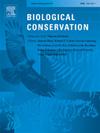监测电子商务平台上的蝙蝠标本制作和标本交易
IF 4.9
1区 环境科学与生态学
Q1 BIODIVERSITY CONSERVATION
引用次数: 0
摘要
野生动物贸易是一项重要的经济活动,但也会对许多物种构成威胁。以前的研究主要集中在蝙蝠(Chiroptera)的食物和药物贸易,但对蝙蝠标本和标本的在线国际贸易知之甚少,而这种贸易被认为是一种新出现的威胁。我们的目标是通过对两个主要电子商务平台进行为期 18 个月的抽样调查来描述这种贸易的特点。我们采用了自动化流程,通过程序访问数据,使用神经网络分类器过滤数据,并使用命名实体识别技术识别相关列表中提及的地点和物种。我们检索到了 40,412 条相关结果,分别代表了 Etsy 和 eBay 上的 2363 条和 2116 条独特的列表。虽然无法验证列表的准确性,但大多数列表(57%)都提供了物种级别的信息。因此,有 47 个蝙蝠物种被挂牌出售,其中 32 个物种目前未被《世界自然保护联盟红色名录》确定为任何目的的交易物种。美国、香港和英国出售的蝙蝠数量最多,而交易物种的分布范围主要在东南亚。我们首次提供了网上蝙蝠交易的纵向数据集,表明一些物种的交易量可能很高,北美和欧洲的需求推动了东南亚的开发。这对于出现密度较低的高交易量物种来说令人担忧,例如画眉蝠(Kerivoula picta)。我们的自动化管道可用于对这一贸易的后续监测,也可用于对其他分类群贸易的监测。本文章由计算机程序翻译,如有差异,请以英文原文为准。
Monitoring the trade in bat taxidermy and specimens on e-commerce platforms
Wildlife trade is a major economic activity but can pose a threat to many species. Previous research has focused on the trade of bats (Chiroptera) for food and medicine but little is known about the online, international trade in bat taxidermy and specimens, which is thought to be an emerging threat. We aimed to characterise this trade by sampling two major e-commerce platforms over an 18-month period. We used an automated pipeline, whereby data were accessed programmatically; filtered using a neural-network classifier; and the locations and species mentioned in relevant listings were identified using Named Entity Recognition. We retrieved 40,412 relevant results, representing 2363 and 2116 unique listings from Etsy and eBay, respectively. Although the accuracy of listings could not be verified, most (57 %) provided species-level information. Hence, 47 bat species were listed for sale, of which 32 are not currently identified by the IUCN Red List as traded for any purpose. The highest number of listings were sold from USA, Hong Kong and the UK, whilst traded species' ranges were predominantly located in South East Asia. We provide one of the first longitudinal datasets on the online bat trade, indicating that several species are being traded at potentially high volumes, with demand from North America and Europe driving exploitation in South East Asia. This is concerning for highly-traded species which occur at low densities, such as the painted wooly bat Kerivoula picta. Our automated pipeline can be used for subsequent monitoring of this trade, or could be adapted for monitoring of trade in other taxa.
求助全文
通过发布文献求助,成功后即可免费获取论文全文。
去求助
来源期刊

Biological Conservation
环境科学-环境科学
CiteScore
10.20
自引率
3.40%
发文量
295
审稿时长
61 days
期刊介绍:
Biological Conservation is an international leading journal in the discipline of conservation biology. The journal publishes articles spanning a diverse range of fields that contribute to the biological, sociological, and economic dimensions of conservation and natural resource management. The primary aim of Biological Conservation is the publication of high-quality papers that advance the science and practice of conservation, or which demonstrate the application of conservation principles for natural resource management and policy. Therefore it will be of interest to a broad international readership.
 求助内容:
求助内容: 应助结果提醒方式:
应助结果提醒方式:


